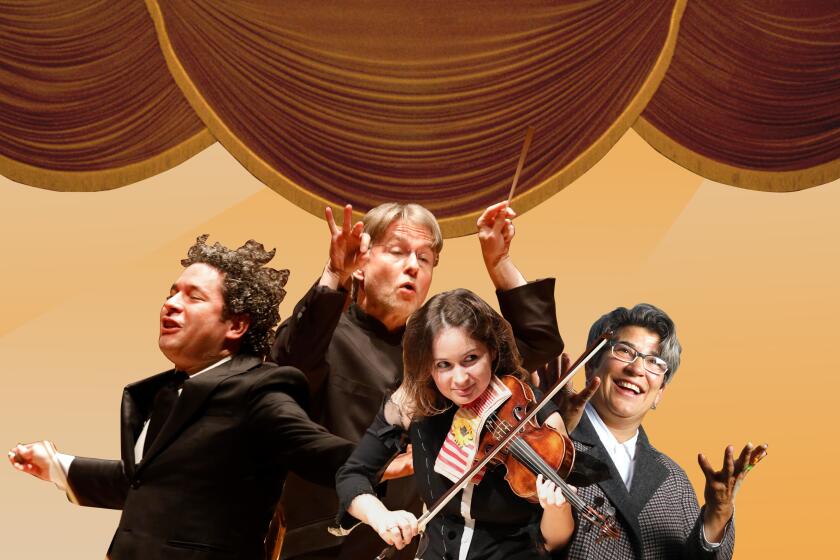Please, can we all listen to some Brahms and learn to get along

- Share via
Aimez-vous Brahms? Some love Brahms, often for the passion. Others can’t stomach the man’s thick-textured, thickly harmonic, tradition-thick music.
LA Weekly music critic Alan Rich led the legions of Brahms haters. At the opposite extreme, New Yorker music critic Alex Ross wrote last spring that, in the wake of his mother’s death, he turned to Brahms “because I always turn to Brahms, in moods bright or dark.” Brahms or no Brahms, Rich so admired Ross’ book “The Rest Is Noise” that he told me it was the one book he wished he had written.
There are great composers who divide people, and Wagner was the most divisive of all. The 19th century Wagner/Brahms split angrily pitted progressives against conservatives. Wagner proclaimed his to be music of the future, whereas Brahms remained stodgy classicist.
But there is another, less acknowledged difference. The worst Wagnerians can be a nasty bunch, as Hitler notoriously demonstrated. Brahms’ music, though, doesn’t ask for allegiance. Brahms, in fact, held in high regard Wagner’s music, if not the anti-Semitic man. Brahmsian Ross happens to be the author of this year’s most talked about music book, “Wagnerism.”
What is it about Brahms that gives us permission to get along and thus makes him such a welcome counterbalancing icon for our contemptible, divisive culture? Francoise Sagan may have hit on the answer in her romantic French novel from six decades ago, “Aimez-vous Brahms?” Swept away, as on a surging melody in a Brahms symphony, we have our flings. We hope to be able to make amends, as Brahms always did in his homage to Old Masters. But like Brahms’ chromatic harmonies, nothing ever truly resolves. Our emotions, like Brahms’ ambiguous rhythmic pulses, remain moving targets. Wagner wrote fanciful, endless melodies. Brahms wrote true-to-life, morphing melodies.
Perhaps this is just the way acrimonious America is these days, but there is no English translation to be found of Sagan’s bestseller. (However, if you happen to read Russian, Romanian, Spanish, German or Arabic, you’re in luck.) Nor is there a readily available domestic DVD, Blu-ray or stream of “Goodbye Again,” the 1961 movie version of the novel. But it is worth checking out on YouTube, despite crummy resolution and sound, the scene in which Ingrid Bergman, about to embark on an affair with an impetuous younger lover, is captivated by the Allegretto from Brahms’ Third Symphony at a concert in Paris.
Her eyes embrace the ups and downs of the movement with the rapt intensity of an orchestra musician following a conductor. Should she submit to the passions of Anthony Perkins (with some “Psycho” still in him) or stick with the fickle sophistication of Yves Montand?
The Piano Quintet in F Minor, Opus 34, has a constant play of heart and soul, impulse and permanence, gloom and exhilaration. Brahms’ greatness is finding balance without downplaying the extremes. His is a middle way in what has been called the crown of Brahms’ chamber music.
In his early 30s when he wrote the quintet, Brahms had some Anthony Perkins and Yves Montand in him. He struggled to balance his own turbulent attractions to and revulsions toward women, having been traumatized growing up in Hamburg and being forced to play the piano as a young boy in late-night spots popular for picking up prostitutes, as is well documented in Jan Swafford’s colorful biography of the composer. Throughout his life, Brahms calmed his hormones — and his harmonies — by grounding himself on classical forms, on what history had shown worked.
The quintet wants to be many things — a symphony, a concerto, modern music, chamber music that harks back to Schubert and Beethoven, a love song, an expression of torment, an attempt at triumph — and Brahms’ mission was first to find a sound for conveying his turbulence. He wrote it initially as a string quintet. That was apparently too sonically bland, too mushy. He destroyed that copy and fashioned a clanky, skeletal version for two pianos. The final form, finished in 1864 around the time he was beginning his “German Requiem,” incorporated the best of both worlds.
This year’s list is devoted to pandemic doers: Dudamel, Salonen, Sharon. Gehry, Borda, Kopatchinskaja, Sorey, Gupta, Grazinyte-Tyla and Edmunds.
May we take a brief “German Requiem” break here to extoll Brahms’ relevance? The term “surge,” so suited to music of Brahms and to the F-Minor Quintet in particular, has taken on troubling connotations at this turn of the pandemic. Though as somber as they come, this requiem is not a Mass and not for the dead. This requiem is for the living, about our responsibility toward the dead. It opens with the line that becomes its theme: “Blessed are they that mourn, for they shall be comforted.” For our caring we are rewarded with stunning beauty.
Comfort finds its way into the quintet with a kind of caring reverence. Time and again, the quintet evokes a quiet mood of contained upset. Brahms deals with it for as long as he can (which isn’t long), then explodes. Swafford likens this to an emotional coiled spring.
Inspired melodies keep changing. Brahms may follow his standard forms like a good student, but he blurs the edges. New melodies are old melodies evolved and transformed. Harmonies bleed dissonances, at times foretelling Schoenberg’s 12-tone methods more than half a century later. Starkly focused rhythms don’t stay that way.
Rather than a Beethovenian transformation of dark to light, these are relative values. Light peeks through the darkness with serene wonder. Light in this quintet is not something sought but something stumbled upon, always there but not noticed.
There is a bigness to the sound of the quintet. The piano and string quartet are not in opposition but in it together. Somehow, the sonic scope projects far more grandeur than you would imagine from five instruments, and by doing so further heightens emotions.
Schoenberg wrote a well-known essay, “Brahms the Progressive.” The great modern radical of the first half of the 20th century, Schoenberg embraced Brahms. It was Brahms, not Wagner, whom Schoenberg taught to his most progressive students — the likes of John Cage and Lou Harrison — and advocated to his friend Henry Cowell.
Ross thoroughly shows how Wagner’s influence is in every bit of Hollywood film music. But the DNA of West Coast music, the music that rethought domineering European patrimony and looked East for inspiration, has Brahmsian code written through it. John Adams’ mentor at Harvard, Leon Kirchner, was another Schoenberg student. La Monte Young, who provided the germ for Minimalism, got his start from Schoenberg’s assistant, pianist Leonard Stein. To that end, six years ago L.A. composer and guitarist Nick Norton, who is equally at home in rock and in Cage, made an orchestral arrangement of the Brahms quintet. It was given its premiere by L.A.’s most mold-breaking conductor, Christopher Rountree.
This further reminds us that progressive and conservative don’t always mean what they seem. Not only was Brahms the progressive, the idol of the liberals, but Wagner, for all his futurism, was the elitist, luxury-needing composer of prejudice embraced by politically conservative nationalists. Banish misleading labels. Play Brahms. And see if we might better get along.
Starting points
For an L.A. Brahmsian kick, listen to a rewarding recording — sumptuously romantic yet ferociously modern — by the Hollywood String Quartet and the pianist Victor Aller. These were studio musicians who played chamber for a respite from Hollywood, and presumably Wagnerism. They were also regular visitors at Schoenberg’s house.
For sheer excitement, the Juilliard String Quartet and Leon Fleisher will clue you to whatever is your sound source.
One of this year’s great losses and a phenomenal Schoenbergian, pianist Peter Serkin recorded a gripping account of Brahms’ Piano Quintet with the Guarneri Quartet in New York in 1995. It has become difficult to find in this country.
The glowing recordingfeaturing another invaluable Schoenberg pianist, Maurizio Pollini, performing with the graceful Quartetto Italiano, has been remastered in hi-def sound.
With live concerts largely on hold, critic Mark Swed is suggesting a different recorded music by a different composer every Wednesday. You can find the series archive at latimes.com/howtolisten, and you can support Mark’s work with a digital subscription.
More to Read
The biggest entertainment stories
Get our big stories about Hollywood, film, television, music, arts, culture and more right in your inbox as soon as they publish.
You may occasionally receive promotional content from the Los Angeles Times.












